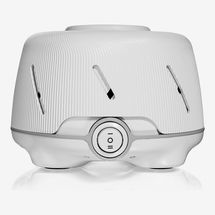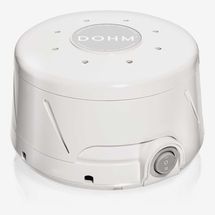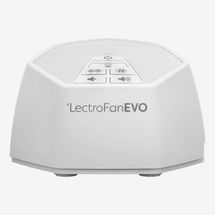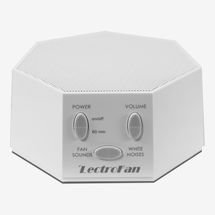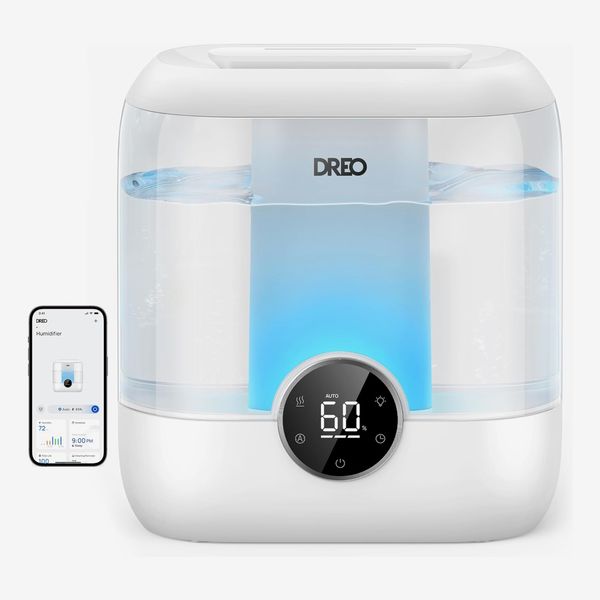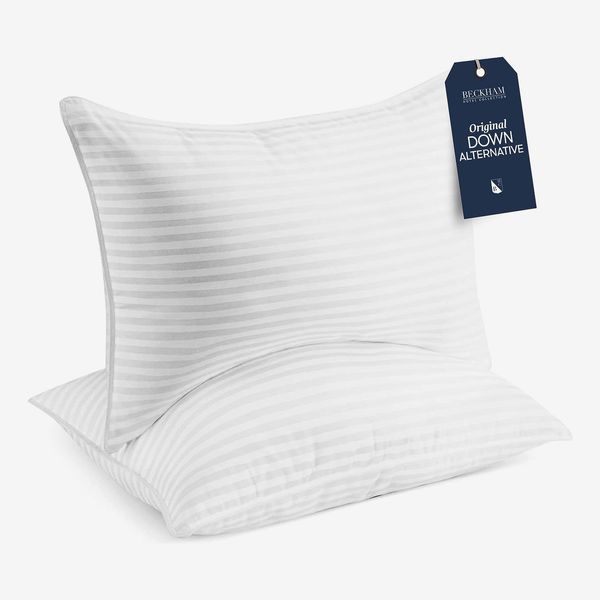
Ask enough sleep nerds about the best sound machines and two very different front-runners will ultimately emerge: the Dohm and the LectroFan. The Dohm, sold by a company called Yogasleep, is a mechanical sound machine that generates white noise via an actual fan whirring inside; it’s been a staple of the white-noise game since 1962. The LectroFan is an electronic sound machine that plays a range of white noise, fan, and ocean sounds. Both are widely popular, and both elicit surprisingly passionate opinions about which one is “better.” After hearing the case for one or the other from multiple Strategist colleagues who’ve tried both, I knew a proper face-off was in order.
Contender #1: The Yogasleep Dohm
Yogasleep makes a few different Dohm products, but for this review I tested the Dohm Sound Machine. Some of my colleagues own the Dohm Classic, which Yogasleep says is mechanically the same as the Dohm Sound Machine, but simply has an older exterior design. (Note that Yogasleep was called Marpac until the company rebranded in 2020, so if you ever see references to the “Marpac Dohm” in Reddit threads or other online debates about sound machines, that’s the same one I’m discussing here.)
Contender #2: The LectroFan Evo
As with the Dohm, there are a few different versions of the LectroFan. I personally tested the LectroFan Evo, which is the newer, updated version of the LectroFan Classic. A few of my colleagues own the LectroFan Classic, which primarily differs from the Evo in exterior design, though it also has two fewer sound options than the Evo.
Sounds
The Dohm is an exceedingly simple machine. It has an internal fan that spins to create the white noise. There are two speed settings for the fan, and two pieces on the outer case that you can twist — one opens or closes holes on top of the machine, and the other opens and closes holes along the sides, allowing air to escape the device differently and slightly altering the fan’s sound and volume between a “lighter, airier” sound and a lower hum.
The LectroFan Evo has 22 electronically generated sounds, including white noise, pink noise, brown noise, fan sounds, and ocean sounds. Since all of the sounds are digitally generated instead of recorded, the company says they will not loop. Most of the Strategist’s LectroFan enthusiasts rarely use any sound other than their chosen fan or white noise sound, but appreciate having the options. Even with its many sound varieties, the LectroFan is geared toward non-specific white noise — you won’t hear any rain storms, chirping crickets, or crackling fireplaces here.
Sound quality
Because the Dohm’s sound is generated by an actual fan, there is something noticeably more “real” about it. I found its white noise far more soothing than the LectroFan’s, and my colleagues on Team Dohm talked up its sound quality as its greatest asset. Senior editor Winnie Yang says the LectroFan’s sounds lack complexity, “whereas with the Dohm I feel like I hear more frequencies. It sounds like you’re standing in a cave with waves crashing outside.” Meanwhile, senior editor Simone Kitchens keeps her Dohm running 24/7, but can only tolerate the LectroFan “on the lowest, most fan-like setting, and can’t stand leaving it on.” The Dohm is also ideal for people who enjoy the sound of a regular old box fan but run too cold for the added gusts that come with.
Though I preferred the richness of the Dohm’s sound overall, I was still impressed by the sound quality of the LectroFan. I’ve tried many electronic sound machines, most of which sound a bit tinny at full volume. But not the LectroFan; the sound remained even and clear when cranked all the way up. My Team LectroFan colleagues sources were not nearly as effusive about the quality of the sound, but also had no complaints.
Volume
It turns out that volume is a key factor in the great sound machine debate, and one of the biggest differences between these two machines: The LectroFan can simply get much louder than the Dohm, and more than one of my LectroFan-loving colleagues named volume as the reason they preferred it over the Dohm. Senior editor Jen Trolio noted that the Dohm was once perfectly loud, but over time she became somewhat desensitized to its sound, and it could no longer mask enough “outside” noise for her liking; since switching to the LectroFan, she hasn’t had this problem. (Yang, for her part maintains that the Dohm is still plenty loud to drown out the street noise of her New York City neighborhood.) When I put the two machines side-by-side at max volume, the LectroFan was considerably louder than the Dohm’s; its electronic sound and internal speaker aren’t hindered by the physical restrictions of a very small fan.
Buttons
There are six buttons on top of the LectroFan Evo; one is a power button, one sets a timer, two control the volume, and two let you cycle through the machine’s 22 sounds. The Dohm is much more minimalist, with a single rocker switch that has three positions: off, slower whirring, and faster whirring.
The simplicity of operating the Dohm is a big selling point for Yang, who dislikes the “dinky” buttons on the LectroFan and the annoyance of having to cycle through so many sound options to find one she likes. “It’s way too easy to accidentally press the wrong button in the dark and end up switching to a different sound, and then you have to go through all of them to find the one you were on,” Yang says. She also pointed out that the single switch on the Dohm is satisfying to operate and makes a good-feeling ‘click.’ I have to agree with Yang here. I appreciated that I didn’t have to futz with the Dohm to settle on a pleasant sound and volume combo; you just flip the switch, maybe twist the outer cap a bit, and go to sleep.
Aesthetics and size
Unfortunately, for a device that sits so visibly on a nightstand or dresser, neither the the Dohm nor the LectroFan is especially good-looking.
The Dohm that I tested is primarily available in white, with a slim accent stripe in gray, pink, blue, or green, though it also comes in charcoal. (Alternatively, the Dohm Classic comes in solid white, gray, black, tan, and pink, if you don’t mind the slightly boxier look of the case.)
The LectroFan Evo only comes in white or black, and while it isn’t exactly design-forward, it’s a little more attractive than the Dohm. The LectroFan is also more obviously a sound machine; I think the Dohm looks a bit like a medical device or Storm Trooper helmet, especially in white.
The two machines are similar in size overall, and neither is designed to be portable, though the LectroFan is smaller. Writer Lauren Ro, who prefers the LectroFan, called out its smaller size as one of her favorite features — she even brings it with her while traveling. The same is true for Yang, who sometimes travels with the LectroFan because it is easier to pack, even though she prefers the Dohm. New York deputy editor Alexis Swerdloff, a recent convert from Dohm to LectroFan, says the LectroFan’s “smaller footprint” is part of what won her over too.
Durability
“I’ve had my Dohm for seven years and I’ve literally only turned it off when I’ve moved,” says Kitchens, noting that she’s never had an issue with its durability. But both Ro and Trolio said the fans in their Dohms stopped working properly after some inadvertently rough handling — Ro dropped hers, and Trolio’s was never the same after a cross-country move. Without the physical fan, the LectroFan is less prone to that kind of damage.
Assorted extras
The Dohm plugs into a standard AC power outlet and has a seven-foot-long cord. The LectroFan must also be plugged in (there’s no battery option) but it can be plugged into a USB port or an AC outlet (and comes with its own adapter). The LectroFan’s cord isn’t as long — about four and a half feet — but shouldn’t be an issue unless your outlets are awkwardly spaced.
The LectroFan also has a timer setting that will turn off the machine automatically, which simply isn’t an option with the Dohm. The lowest timer setting is one hour and it can be increased in one-hour increments up to eight hours.
The verdicts
Get the Dohm if you are picky about sound quality and want set-it-and-forget-it simplicity over all else — it is easier to use, and has the je ne sais quoi of “real” white noise generated by a whirring fan. Between Kitchens, Yang, and myself, the Dohm wound up with three votes from the Strategist staff.
Get the LectroFan if you want a variety of sounds to choose from, maximum volume, and a slightly sleeker look in a smaller, more travel-friendly package. As long as the electronically generated noise won’t leave you wanting, it has plenty going for it — including votes from Ro, Swerdloff, and Trolio for an even three-to-three tie.
The Strategist is designed to surface useful, expert recommendations for things to buy across the vast e-commerce landscape. Every product is independently selected by our team of editors, whom you can read about here. We update links when possible, but note that deals can expire and all prices are subject to change.

